Methods
Optical spectroscopy, Magnetooptics
Light scattering (Raman, Brillouin)
Spin-polarized photoemission
Tunneling, spin-polarized
SQUID magnetometry
Ultrafast optical and electrical pump-probe experiments
Ultrafast time-resolved magnetooptics and spin dynamics
Spin transport in nanostructures
MBE (Molecular Beam Epitaxy), Ultrathin Film Technology, Nanopatterning

Topics
Magnetic semiconductors
For the europium chalcogenides EuX (X = O, S, Se, Te) the central issue in the 60s and 70s was the exchange interaction between the atomic-like, localized 4f states and the 5d, 6s band states and their involvement in the magnetooptical properties.
Energy level scheme and the effect of magnetic order on the optical transitions in europium chalcogenides
G. Güntherodt, P. Wachter & D. M. Imboden,
Physik der kondens. Materie 12, 292 (1971)
Optical properties and electronic structure of europium chalcogenides
G. Güntherodt, Physics of condensed matter 18, 37 (1974)
Physics of condensed matter 18, 37 (1974)
Valence fluctuations
The interaction of atomic-like, localized 4f electrons near the Fermi level with itinerant conduction electrons leads to valence fluctuations of the rare earth (RE) ions with 4fn → 4fn-1 + e– at EF. One question concerned the identification of the ionic level structure of individual ions involved in the fluctuation.
Direct Observation of Intraionic and Interconfigurational Excitations in an Intermediate-Valence Compound by Raman Spectroscopy
E. Zirngiebl, S. Blumenröder, G. Güntherodt, A. Jayaraman, B. Batlogg, and M. Croft
Phys. Rev. Lett. 54, 213 (1985)
https://doi.org/10.1103/PhysRevLett.54.213
Half-metallic ferromagnets
Theoretical discovery of CrO2 as half-metallic ferromagnet in 1986 by K.H. Schwarz (J.Phys. F 16, L211 (1986)), i.e. it is a metal for spin-up electrons and shows a semiconductor-type gap for spin-down electrons. Triggered by my colleagues at IBM Research Yorktown Heights the experimental proof of this feature was initiated in 1986 during my stay as IBM World Trade Visiting Scientist.
CrO2—A New Half-Metallic Ferromagnet?
K. P. Kämper, W. Schmitt, G. Güntherodt, R. J. Gambino, and R. Ruf
Phys. Rev. Lett. 59, 2788 (1987)
The high spin polarization (>95%) near the Fermi energy of CrO2 thin films was in turn used as spin-polarized current source in an STM tip to realize the first spin-polarized vacuum tunneling experiment.
Observation of vacuum tunneling of spin-polarized electrons with the scanning tunneling microscope
R. Wiesendanger, H.-J. Güntherodt, G. Güntherodt, R. J. Gambino, and R. Ruf
Phys. Rev. Lett. 65, 247 (1990)
https://doi.org/10.1103/PhysRevLett.65.247
A central issue concerned the role of electronic correlations in the transition metal oxide CrO2. A final answer was given in 2018 by soft-X-ray angle-resolved photoemission (SX-ARPES) measurements and a comparison between DFT and DMFT calculations of the electronic band structure.
Weakly-Correlated Nature of Ferromagnetism in Nonsymmorphic CrO2 Revealed by Bulk-Sensitive Soft-X-Ray ARPES
F. Bisti, V.A. Rogalev, M. Karolak, S. Paul, A. Gupta, T. Schmitt, G. Güntherodt, V. Eyert, G. Sangiovanni, G. Profeta, and V. N. Strocov, Phys Rev. X 7, 041067 (2017) (arXiv: 1607.01703)
Itinerant magnetism
In the 70s of the 20th century a central question in itinerant magnetism concerned the temperature dependence of the exchange splitting Dex, i.e. according to the temperature dependence of magnetization M(T) (Stoner model) or as temperature independent (local moment model), triggered by the observation of spin waves above the Curie temperature TC.
Temperature Dependence of the Exchange Splitting in Ni Studied by Spin-Polarized Photoemission
H. Hopster, R. Raue, G. Güntherodt, E. Kisker, R. Clauberg, and M. Campagna
Phys. Rev. Lett. 51, 829 (1983)
Temperature and wave-vector dependence of the spin-split band structure of Ni(111) along the Γ-L line
K.-P. Kämper, W. Schmitt, and G. Güntherodt
Phys. Rev. B 42, 10696 (1990)
Conclusion: Angle- and spin-resolved photoemission spectra of the exchange-split bands of Ni(110) in the temperature range 0.5 ≤ T/TC ≤ 0.94 show neither a temperature-independent Dex (“local band theory”) nor a collapsing Dex (Stoner model). The temperature dependence of Dex depends on the individual k point and its group velocity. Spin fluctuations near TC strongly influence the photoemission line shapes.
Surface Magnetism
Magnetic Superlattices
The staggering of thin ferromagnetic and nonmagnetic layers leads to novel collective properties different from the properties of individual layers. This concept was pioneered by I.K. Schuller and C.M. Falco at the Argonne National Laboratory, USA.
Metallische Übergitter
B. Hillebrands und G. Güntherodt, Physikal. Blätt. 45 (11), 447 (1989)
https://doi.org/10.1002/phbl.19890451110
International Conference on Metallic Multilayers 2001 (MML’01) in Aachen
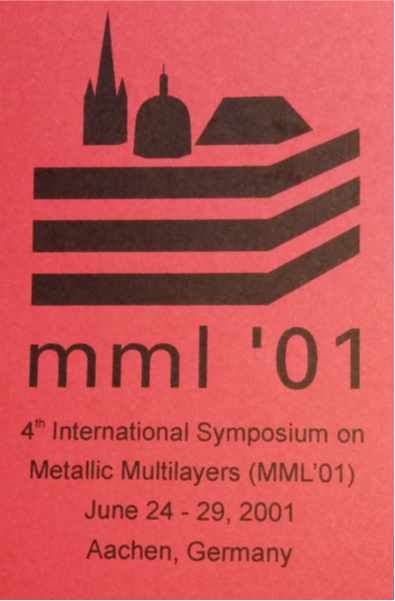
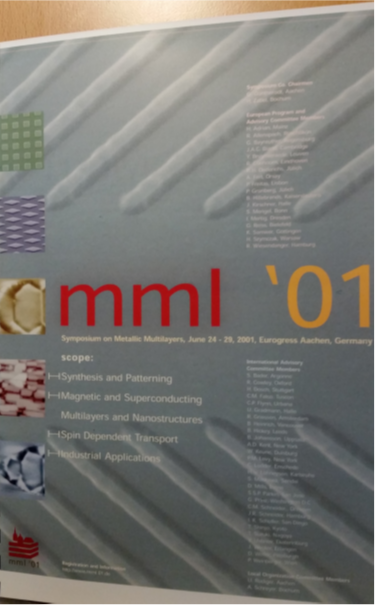
High temperature superconductors
Quantum spin systems
Nanomagnetism, Exchange bias
Magnetic Nanoparticles
Spintronics (metals, semiconductor, graphene)
Nanotechnology


Coordinators from electrical engineering (H. Kurz), chemistry (U. Simon), materials science (J. Mayer), medical science (J. Floege) and physics (G. Güntherodt). To be continued by FIT section (Future Information Technology) of Jülich-Aachen Research Alliance (JARA).
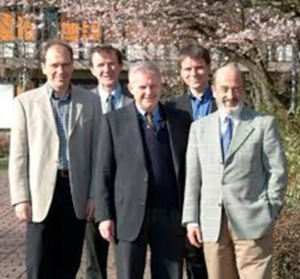
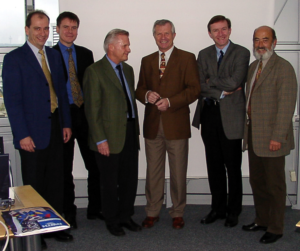
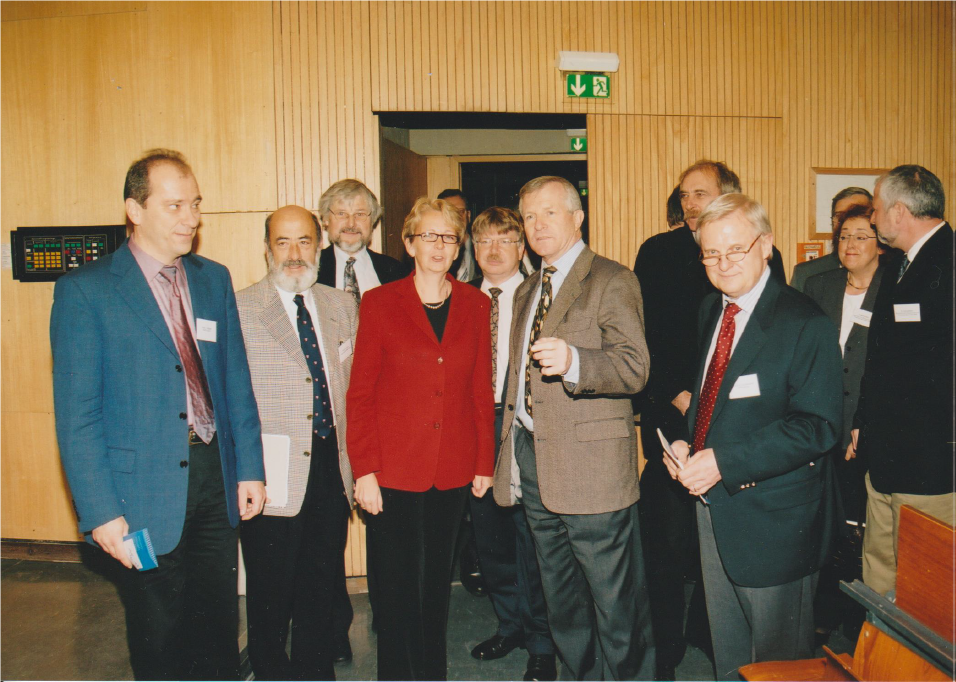
RWTH NanoClub at Khalifa University Abu Dhabi 2005

Nanooptics
Quantitative determination of the local Kerr rotation by scanning near-field magneto-optic microscopy (SNOM)
P. Fumagalli, A. Rosenberger, G. Eggers, A. Münnemann, N. Held, and G. Güntherodt
Appl. Phys. Lett. 72, 2803 (1998) https://doi.org/10.1063/1.121463
Polarization effects of imperfections in conducting and dielectric samples imaged with polarization-sensitive scanning near-field optical microscopy (SNOM)
G. Eggers, A. Rosenberger, N. Held, G. Güntherodt, P. Fumagalli, Appl. Phys. Lett. 79, 3929 (2001)